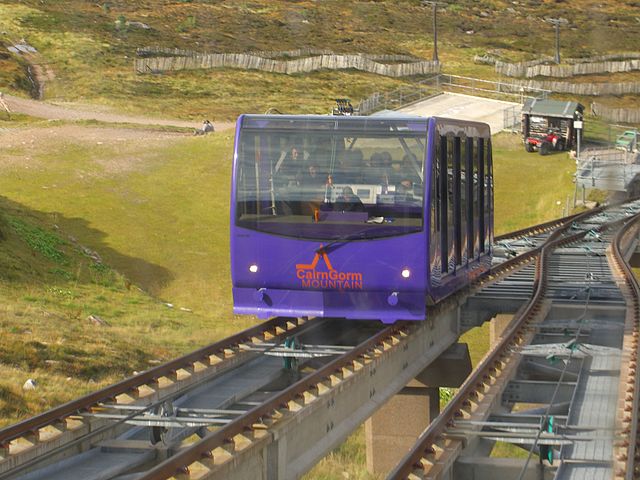The Cairngorm Mountain Railway, which opened in 2001, is the highest railway in the United Kingdom. The two-kilometre long funicular ascends the northern slopes of Cairn Gorm, the United Kingdom’s sixth-highest mountain, serving the Cairngorm Mountain ski resort. The route and ski area are located within the Cairngorms National Park, the largest National Nature Reserve in Britain, located near Aviemore in the Highland council area of Scotland.
It is owned by the Highlands and Islands Enterprise and was operated by Cairngorm Mountain Limited until July 2014 when Natural Retreats UK took over the lease.
History
Construction of the Cairngorm Mountain Railway started in 1999 and the railway opened on 24 December 2001 (forty years after the opening of the White Lady Chairlift, which it replaced). The construction was initiated because the chairlift was too sensitive to the strong winds in the area. The track is a broad gauge of 2,000 mm (6 ft 6 3⁄4 in). The maximum operating speed is 10 metres per second (32.8 ft/s) (36 km/h or 22 mph) during the ski season and 5 metres per second (16.4 ft/s) the rest of the year. At these speeds, the trip takes about four minutes in winter and nine minutes during the summer (calculated without middle station stops). The single track line has a passing loop just above the middle station. During ascent, the maximum gradient is 23° (1 in 2.5, or 40-percent inclination). The railway starts at the Base Station in the Coire Cas area, where there is a restaurant, shop, ticket office, hire shop, rangers’ office and Disability Sport UK office. The Scottish Ski Club has a building close to the middle station.
At peak times there can be 150,000–160,000 non-winter sports visitors, combined with a further 50,000–120,000 annual sports visitors during the winter. CML can expect to cater to 1000 visitors per day in the summer months.
The railway is 13 kilometres (8 mi) from Aviemore and can be reached traveling along the B970 and C38 roads to Glenmore. From Glenmore a route is taken through the snow gates and via a one-way system past Coire na Ciste (approximately 3 km or 1.9 mi. The Base Station is at an altitude of approximately 635 metres (2,083 ft) above sea level, the middle station is at approximately 765 metres (2,510 ft) and the top Ptarmigan Station is at approximately 1,097 metres (3,599 ft).
The total length of the funicular railway track is 1,970 metres (6,460 ft), during which the route rises by 462 metres (1,516 ft). Most of the route is single track, with a short passing loop near half way. Up to 120 standing passengers can be carried in each of the system’s two carriages. The train is fully accessible for wheelchair users and both the Base Station and Ptarmigan Station have lift access to all levels.
Depending on wind direction, wind speed trend and weather forecast the trains can operate in winds of 100 to 120 km/h (60 to 75 mph). As the train approaches the top station it enters a 250-metre-long (820 ft) cut and covered tunnel taking it up to the top platform hidden in the hillside.
The funicular railway operates by ‘hauling’ up one carriage using electric motors to pull the haul rope as the other carriage descends at the same time. The system is powered by two stationary in series 500 kW electric motors, a gear box and a ‘soft start-soft stop’ control system which can increase the electrical frequency and vary the current and voltage to control the carriage speeds as they approach or leave a station. A hydraulically operated ‘counter’ rope is connected to both carriages to maintain haul rope tension. The two carriages are permanently connected by the haul rope and the counter rope and can never operate independently.
The funicular railway system is normally operated from a manned control room within the Ptarmigan building but can also be operated from the Base station control room or from each railway carriage. There are dedicated sophisticated computer control, instrumentation, communication and safety systems for the railway which have a range of back up systems and there are also standby generators and manual back up systems for moving the carriages.
During the ski season, skiers are asked to stay within the designated ski area[vague] and climbers and hill walkers are not allowed to use the railway to travel uphill. The railway operators have agreed, in conjunction with Scottish Natural Heritage (SNH), to operate a formal visitor management plan to protect fragile areas of the mountain environment. This means that for conservation reasons, the public is not allowed to access the mountains during the summer season from Ptarmigan building. However, walkers who have climbed the hill themselves may purchase a downhill ticket at the Ptarmigan building for travelling back down to Base. There are no middle station stops or exits during the summer.
Discover more from LandmarkLocation.com
Subscribe to get the latest posts sent to your email.


